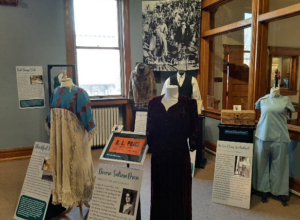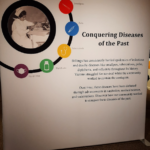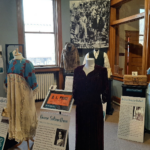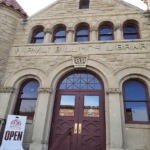
Want to. . . see more of the Billings community. . . get off-campus. . . learn something new? If any of these answers are yes, The Western Heritage Center (WHC) is a great place for you to visit! WHC is a museum that continually changes its exhibits every three months, and their four new exhibits just opened this March.
Community Historian of WHC Lauren Hunley states, “There are a lot of reasons why college students, in particular, should visit the Western Heritage Center and to explore other museums. One, museum exhibits are designed to explore challenging subjects, to raise interesting questions, and to help you recognize your role and your place in your community.”
Hunley goes on to say, “Most of our exhibits include an area where you can share your own experiences. That allows your voice to become a part of the historic record. It really gives you an opportunity to inform and influence your community, which is something that a lot of college students don’t think they have [sic] that power, but the museum is one way you can practice that.”
The exhibits at WHC vary in topics so you will definitely learn and see something new that challenges and influences you and your community. The first, Conquering Diseases of The Past, covers five epidemics with which the Billings community has struggled. This exhibit has a unique interactive aspect that allows you to follow a historical person’s fight with either smallpox, polio, tuberculosis, diphtheria, or flu of 1918 and find out if the individual survived. Then you can also add to the historical record by writing about your own experiences with diseases.
In the next room, the other original exhibit WHC created is Sewn Together: Stories from the Museum’s Clothing Collection, which features 25 pieces. Each piece of clothing is tied to local history—whether that is a story of a person, location, fashion trend, or event.
The final two exhibits at WHC are partnered with other museums and organizations. The Beartooth Highway, Building the “Most Beautiful Road in America” is on loan from Carbon County Museum and Historical Society. Hunley explains, “The exhibit itself is really neat. It has some great photographs, but the exhibit also illustrates the partnerships we have across the region,” and points out that these partnerships allow the Billings community to be exposed to new stories. Finally, they have The Avis Marvelous: Ornithology on the Western Frontier, 1776-1896, which are historic lithographs of Western birds paired with taxidermied mounts. For this exhibit, the WHC partnered with the Audubon Center and Zoo Montana.
While they have all of these exciting new exhibits, the Western Heritage Center also has many resources and opportunities that are beneficial to college students.
From oral histories to photographs to rare books, the WHC has many unique research capabilities. Hunley explains, “So for any college student who is working on a project, or writing a paper, or doing research, we are a fantastic resource to expand and build that information. We have trained research professionals and researchers available to help you. We are like the library, but with older stuff.”
The Western Heritage Center also offers internship possibilities that they will try to tailor to your major to give you many practical job skills that will help to bolster your resume. Or you can volunteer with them to get a similar experience. As a volunteer, you can work at the front desk, help with research, and/or aid in exhibit installations.
To use any of these resources, volunteer, or get information about an internship, all you have to do is ask! You can contact the Western Heritage Center at 406-256-6809.
Hunley ends by discussing that she is proud of the work the WHC has been doing to create a space for voices that have been ignored or marginalized in the past. She states that through using direct quotations, “It allows a deeper sense of emotional connection and emotional relativity to our visitors. We don’t really filter that information. This means we are telling stories that can be really challenging, but incredibly illuminating in helping us understand our current environment. . . we continue to seek out people who have these stories and information that don’t feel represented.”
Go explore the Western Heritage Center, whether you want to enjoy the new exhibits or utilize the resources and opportunities the WHC offers!



